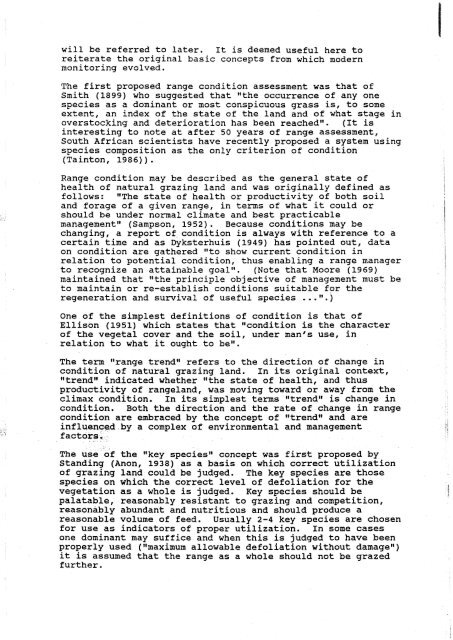soil-conservation-people-religion-and-land.pdf - South West NRM
soil-conservation-people-religion-and-land.pdf - South West NRM
soil-conservation-people-religion-and-land.pdf - South West NRM
You also want an ePaper? Increase the reach of your titles
YUMPU automatically turns print PDFs into web optimized ePapers that Google loves.
will be referred to later. It is deemed useful here to<br />
reiterate the original basic concepts from which modern<br />
monitoring evolved.<br />
The first proposed range condition assessment was that of<br />
Smith (1899) who suggested that "the occurrence of any one<br />
species as a dominant or most conspicuous grass is, to some<br />
extent, an index of the state of the l<strong>and</strong> <strong>and</strong> of what stage in<br />
overstocking <strong>and</strong> deterioration has been reached". (It is<br />
interesting to note at after 50 years of range assessment,<br />
<strong>South</strong> African scientists have recently proposed a system using<br />
species composition as the only criterion of condition<br />
(Tainton, 1986) ) .<br />
Range condition may be described as the general state of<br />
health of natural grazing l<strong>and</strong> <strong>and</strong> was originally defined as<br />
follows: "The state of health or productivity of both <strong>soil</strong><br />
<strong>and</strong> forage of a given range, in terms of what it could or<br />
should be under normal climate <strong>and</strong> best practicable<br />
management" (Sampson, 1952). Because conditions may be<br />
changing, a report ~f~condition is always with reference to a<br />
certain time <strong>and</strong> as Dyksterhuis (1949) has pointed out, data<br />
on condition are gathered Ifto show current condition in<br />
relation to potential condition, thus enabling a range manager<br />
to recognize an attainable goal1v. (Note that Moore (1969)<br />
maintained that "the principle objective of management must be<br />
to maintain or re-establish conditions suitable for the<br />
regeneration <strong>and</strong> survival of useful species ...fr.)<br />
One of the simplest definitions of condition is that of<br />
Ellison (1951) which states that "condition is the character<br />
of the vegetal cover <strong>and</strong> the <strong>soil</strong>, under man's use, in<br />
relation to what it ought to be".<br />
The term "range trendv1 refers to the direction of change in<br />
condition of natural grazing l<strong>and</strong>. In its original context,<br />
lgtrendvl indicated whether "the state of health, <strong>and</strong> thus<br />
productivity of rangel<strong>and</strong>, was moving toward or away from the<br />
climax condition. In its simplest terms @@trendwt is change in<br />
condition. Both the direction <strong>and</strong> the rate of change in range<br />
condition are embraced by the concept of "trend" <strong>and</strong> are<br />
influenced by a complex of environmental <strong>and</strong> management<br />
factors,<br />
The use of the "key speciesg1 concept was first proposed by<br />
St<strong>and</strong>ing (Anon, 1938) as a basis on which correct utilization<br />
of grazing l<strong>and</strong> could be judged. The key species are those<br />
species on which the correct level of defoliation for the<br />
vegetation as a whole is judged. Key species should be<br />
palatable, reasonably resistant to grazing <strong>and</strong> competition,<br />
reasonably abundant <strong>and</strong> nutritious <strong>and</strong> should produce a<br />
reasonable volume of feed. Usually 2-4 key species are chosen<br />
for use as indicators of proper utilization. In some cases<br />
one dominant may suffice <strong>and</strong> when this is judged to have been<br />
properly used (vlmaximum allowable defoliation without damageRf)<br />
it is assumed that the range as a whole should not be grazed<br />
further .
















